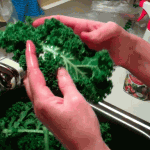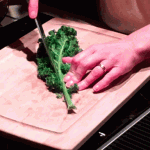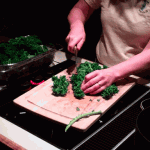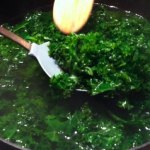I’m sure a lot of people have never tried kale because they don’t know how to cook kale. I was one of those people too until just a few years ago. That was when I discovered that kale is a great tasting, highly nutritious leafy green vegetable, similar to spinach.
Kale is best when fresh, so cook it within a few days after you buy it at the grocery store. Make sure it’s a nice dark green with firm leaves and no brown spots or flimsy areas.
Kale is also very inexpensive, especially when you buy it in season. I can get a huge bunch of it in season (January-March) for about $1.29.
[Time saving tip: Make the whole bunch at once, even if you won’t eat it all that night. Store the rest in the frig for a few days. Then you can briefly microwave it and serve with another meal. That’ll save you a lot of time.]
There are three simple steps to preparing kale: wash, cut, and cook.
Wash the Kale

If it’s not organic, spray it with a natural fruit and vegetable cleaning spray first. This will absorb the fertilizers and toxins used in the growing process. It feels a little slimy when sprayed on, but when rinsed off it takes all that nasty gunk with it and feels nice and clean.
Kale has a lot of curly little nooks and crannies, so make sure to rinse it thoroughly under running water. Get all the little grains of dirt out. As you rinse it you can just dump it right into a big colander.
Let the kale drain in the colander for 5-10 minutes before cutting it. (Prepare some other part of your meal in the meantime.)
Cut the Kale

Kale leaves have a big thick stalk, which tapers to a point in about the middle of the leaf. The stalk is very fibrous, chewy, and not as pleasant to eat as the leaves. Some people keep the stalk, but I prefer to cut it out, I just want the leaves.
Remove the stalk of each kale leaf by slicing up the side of the stalk on both sides with a sharp knife. Start at the base of the stalk, where the leaf starts to come out of the stalk, and move up the leaf.
At the top of the stalk it gets narrower and ultimately comes to a point. The leaf also gets thicker as you go up. Once you’ve sliced up both sides, the stalk basically comes right out.
There are also some little clingy leaves at the bottom of the stalk. You can just pull those off with your fingers and add them to your leaf pile.

Still using your sharp knife, cut the rest of the leaves into bite size pieces. After you’ve cut out the stalk from maybe three or four leaves, stack them up together. Cut them crosswise into bands of 1-1/2 to 2 inches wide. You should have a large pot of cold water ready, right next to you, and you can toss them right into the cold water. Don’t turn the heat on yet though. Just keep going until you’re finished cutting the whole bunch
Cook the Kale
There are two things I’ve learned about kale that are worth keeping in mind.
1) It’s easiest to prepare by boiling. I don’t generally boil vegetables because it removes more of the nutritional value, but I’ve tried several other ways to cook kale. Boiling is easiest to get it right. Sauteing is better nutrionally but takes longer, at least twice as long as boiling, and the end result is not quite as appealing. Unless you are an experienced cook I wouldn’t recommend it.
2) It takes a lot longer than spinach. Since it’s to similar to spinach it’s easy to assume that cooking it for 3-5 minutes is plenty. It’s not. Boil it for 8-10 minutes. The exception is if you happen to get your hands on really young kale, it won’t take that long. Maybe 6-8 minutes. Young kale is smaller and thinner and not as dark as mature kale, and rarely seen in your local every day grocery store.
So you’ve got your chopped-up kale in a big pot of cold water. The kale floats so it’s hard to see when you’ve got too much water. You only need enough water to “cover” the kale, so push it around with a spoon to see how much you’ve got and remove some water if there’s too much.
Turn the heat on high under the pot of kale and let it come to a boil. Then turn the heat down and simmer the kale for about 10 minutes. Then taste it. It should be relatively soft but not as soft as spinach. Maybe as soft as a well-sauteed mushroom. I know that sounds odd, but that’s what comes to mind.

If it’s done you can pull it out with a strainer or slotted spoon. I like to use one of those chinese stir-fry spoons, with the bamboo handle and metal mesh scoop. Put it back in your colander and push down on it gently with your spoon to squeeze some more of the water out. [Note for those of you who watched my video on how to prepare kale: I did not drain the excess water out and I regretted that because it was too wet when we ate it.
Season to taste. Kale holds up well to a variety of basic seasonings. In the video I used olive oil and Mrs. Dash onion and herb blend. I’ve also used garlic, sauteed onions, garlic salt, butter, Adobo, and just plain old salt and pepper. Do whatever suits you — experiment a little.
Buen Provecho!
———————————–
Kale’s Nutrition
Serving Size: 1 Cup
Calories – 36
Fat – .5 g
Fiber – 2.5 g
Carbohydrates – 7 g
Protein 2.5 g
Kale’s other nutritional benefits: Cancer fighting food, high in antioxidants, Vit C, Vit K, Vit A. Also a moderately good source for calcium and iron.
